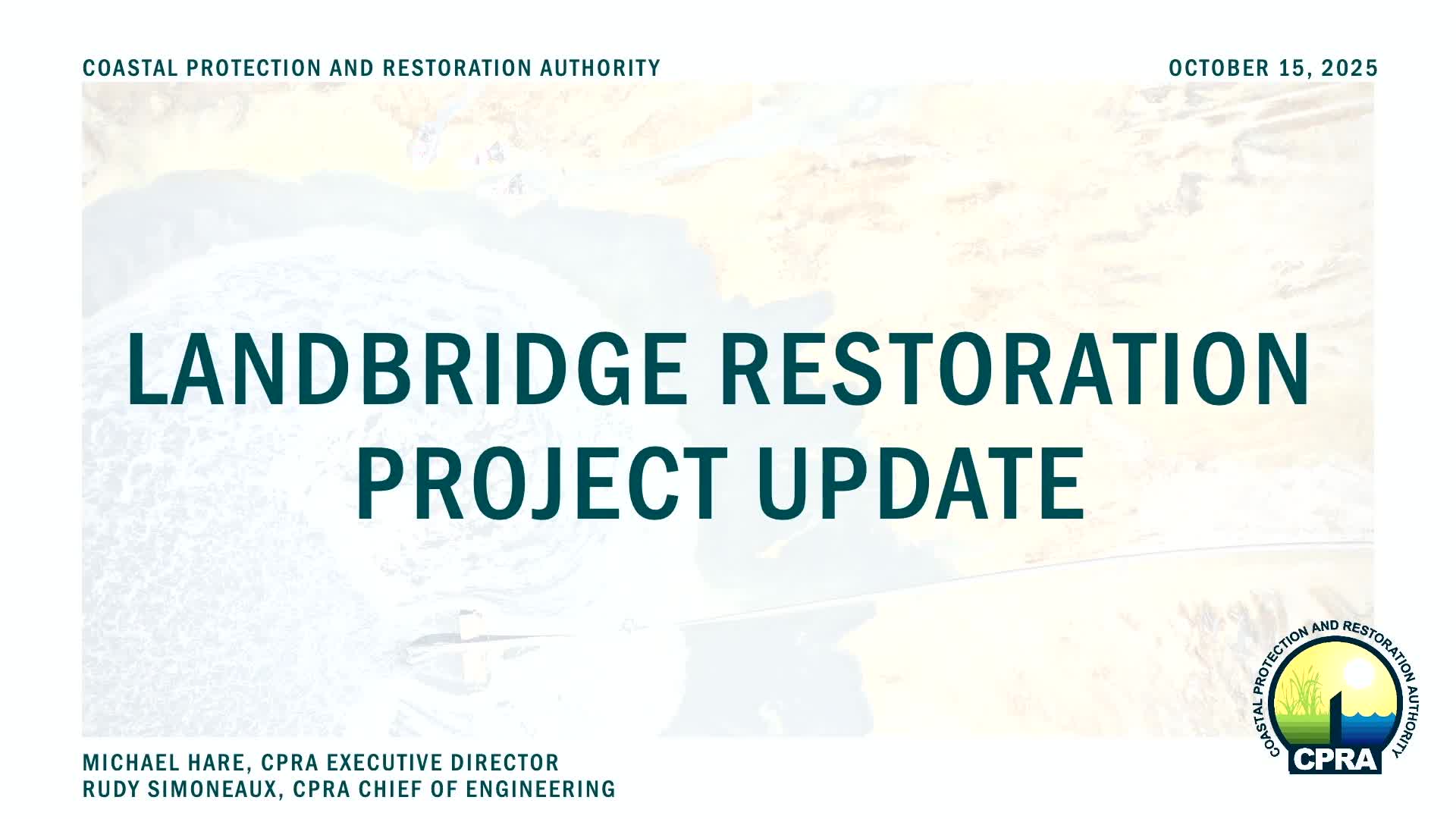CPRA lays out near‑term plan for large-scale 'land bridge' restorations, seeks phased design and construction
October 20, 2025 | Coastal Protection and Restoration Authority Board, Boards & Commissions, Organizations, Executive, Louisiana
This article was created by AI summarizing key points discussed. AI makes mistakes, so for full details and context, please refer to the video of the full meeting. Please report any errors so we can fix them. Report an error »

CPRA engineers presented a new, programmatic approach for large-scale linear marsh and ridge restorations — commonly called “land bridges” — describing the concept, past precedents and next steps to convert master-plan features into multiple design-plus-construction packages.
Ray, identified in the meeting as CPRA’s chief of engineering, told the board that “land bridges” are large, linear features that combine marsh creation, raised ridges and shoreline protection to reduce tidal exchange across open-water corridors and to protect interior marshes. The agency showed examples including the Spanish Pass project (an earlier river-sand marsh-creation and ridge project) as proof of concept, and staff described how a larger-scale feature in the master plan could exceed 10,000 acres in its benefit area.
CPRA outlined a phased work plan: (1) screen alternative alignments within a broad domain, (2) collect field data and refine an alignment, (3) break the land-bridge feature into multiple design packages, and (4) proceed to construction on those packages that are permitted and funded sooner. Staff said some smaller, fully designed packages already exist in the design queue and could be advanced to construction while the larger alignment and modeling continue.
CPRA said the land‑bridge concept will use different sediment sources depending on location — Mississippi River sediment where available and other offshore or gulf-source methods where river sand cannot be used — and that construction methods and equipment will vary by site. Presenters also emphasized the importance of access planning and the potential for higher initial elevations (in some cases up to 5½ feet or higher where river sand was used) to produce durable features that can provide a more immediate storm-buffering function.
Why it matters: The land‑bridge concept is a central element in the CPRA master plan’s large‑scale restoration portfolio. CPRA’s programmatic approach is intended to turn conceptual master-plan features into actionable, fundable projects that can be engineered and delivered in phases.
Next steps CPRA outlined: a near-term alignment and screening report, data-collection and a set of design packages by 2026, and concurrent construction of pre‑qualified segments wherever funding and permits allow.
Ray, identified in the meeting as CPRA’s chief of engineering, told the board that “land bridges” are large, linear features that combine marsh creation, raised ridges and shoreline protection to reduce tidal exchange across open-water corridors and to protect interior marshes. The agency showed examples including the Spanish Pass project (an earlier river-sand marsh-creation and ridge project) as proof of concept, and staff described how a larger-scale feature in the master plan could exceed 10,000 acres in its benefit area.
CPRA outlined a phased work plan: (1) screen alternative alignments within a broad domain, (2) collect field data and refine an alignment, (3) break the land-bridge feature into multiple design packages, and (4) proceed to construction on those packages that are permitted and funded sooner. Staff said some smaller, fully designed packages already exist in the design queue and could be advanced to construction while the larger alignment and modeling continue.
CPRA said the land‑bridge concept will use different sediment sources depending on location — Mississippi River sediment where available and other offshore or gulf-source methods where river sand cannot be used — and that construction methods and equipment will vary by site. Presenters also emphasized the importance of access planning and the potential for higher initial elevations (in some cases up to 5½ feet or higher where river sand was used) to produce durable features that can provide a more immediate storm-buffering function.
Why it matters: The land‑bridge concept is a central element in the CPRA master plan’s large‑scale restoration portfolio. CPRA’s programmatic approach is intended to turn conceptual master-plan features into actionable, fundable projects that can be engineered and delivered in phases.
Next steps CPRA outlined: a near-term alignment and screening report, data-collection and a set of design packages by 2026, and concurrent construction of pre‑qualified segments wherever funding and permits allow.
View full meeting
This article is based on a recent meeting—watch the full video and explore the complete transcript for deeper insights into the discussion.
View full meeting
